Using drone-based lidar, researchers mapped two medieval cities in Uzbekistan, Tashbulak and Tugunbulak, revealing detailed urban structures important to the history of the Silk Road. The first use of drone-based lidar in Central Asia has allowed archaeologists to reveal details of two recently discovered medieval trading cities high in the mountains of Uzbekistan.
The team used this advanced technology to map the archaeological scale and location of cities that were among the largest ever documented in the mountainous regions of the Silk Road, the vast network of ancient trade routes connecting Europe and East Asia.
St. The research, led by Michael Frachetti, professor of archeology in the Department of Arts and Sciences at Washington University in St. Louis, and Farkhod Maksudov, director of the National Archeology Center in Uzbekistan, was recently published. Nature.
Ancient urbanism in high resolution
Drone lidar scanning provided highly detailed images of the squares, walls, roads and settlements that shaped the lives and economies of highland communities, traders and travelers in Central Asia from the 6th to the 11th centuries. The two cities are located on rugged terrain between 2,000 and 2,200 meters above sea level (roughly comparable to Machu Picchu in Peru), making them unusual examples of thriving mountain urbanism.

Uncovering the complexities of mountain urbanism
The smaller city, today called Tashbulak, covered an area of about 12 hectares, while the larger city of Tugunbulak reached 120 hectares, making it “one of the largest regional cities of its time,” Frachetti said.
“These would be major urban centers in Central Asia, especially as you move from lowland oases to more challenging mountainous conditions,” he said. “Although mountains were often seen as obstacles to trade and movement along the Silk Road, they were actually the site of major centers of interaction. Animals, ores, and other valuable resources likely contributed to their prosperity.”
“This place had a complex urban structure with a specific material culture, significantly different from the settled culture of the plain,” Maksudov said. he said. “It is clear that the people who lived in Tugunbulak more than a thousand years ago were nomadic herders who maintained their own independent culture and political economy.”

Technological developments in archaeological research
Lidar technology is often used to map archaeological sites blocked by dense vegetation, but it provides added value in places where vegetation is sparse, such as the mountains of Uzbekistan. “The operation of drones is strictly regulated in Uzbekistan, so this discovery was also made possible thanks to the political support and permissions we received from local partners and the government,” Frachetti said. he said.
Centimeter-level scanning has enabled advanced computer analysis of ancient archaeological surfaces, providing unprecedented insight into the architecture and organization of cities. “These are some of the highest resolution lidar images of archaeological sites ever published,” Frachetti said. “This was possible thanks to the unique erosion dynamics in this particularly mountainous region.”
Combination of modern technologies and ancient discoveries
Using predictive computer models and old-fashioned surveys between 2011 and 2015, Frachetti, Maksudov and their team first explored the highland cities and traced the so-called routes of the Silk Road in southeastern Uzbekistan. It took years to implement the project. In the end, the extra time turned out to be a blessing, allowing the researchers to make the most of the latest advances in drone-based lidar. “The final high-resolution maps were created from more than 17 drone flights over a three-week period,” Frachetti said. he said. “It would take us decades to map such large regions by hand.”
Frachetti and his graduate students compiled the drone lidar data into a 3D model in the Spatial Analysis, Interpretation, and Research (SAIE) laboratory and gave it to computer science and engineering professor Tao Ju and undergraduate student Xiaoyi Liu. both at the University of Washington McKelvey School of Engineering. Zhu and Liu applied computational algorithms to analyze archaeological surfaces and automatically trace millions of lines to predict possible architectural alignments. The final step was to match the digital output with comparable architectural features, revealing a vast ancient city normally invisible to the naked eye. “The project represents a truly interdisciplinary effort,” Zhu said. “The analysis methods have potential applications in many areas where lidar scanning is used.”
Future Excavations and Implications
Frachetti said both cities need a closer look. Preliminary excavations at one of the fortified structures in Tugunbulak suggest that the castle, protected by three-meter earthen walls, may have been a factory where local blacksmiths converted rich iron ore deposits into steel. Such an industry would be an important feature of the city and its economy.
It is already clear that Tasbulak and Tugunbulak are not just remote outposts or resting places. “The Silk Road wasn’t just about China and the fringes of the West,” Frachetti said. “The main political forces were active in Central Asia. The complex heart of the network also became a driver of innovation.”
Frachetti hopes to use a combination of on-site detective work and drone-based lidar to photograph other high-altitude settlements on the Silk Road and beyond. “We could really change the map of urban development in medieval Asia,” he said.
Source: Port Altele
